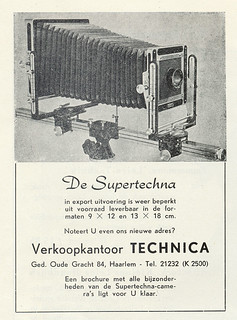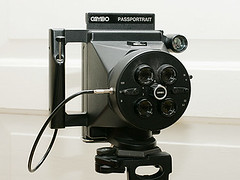Difference between revisions of "Cambo"
(→Older cameras: +Explorer in camera list) |
Hanskerensky (talk | contribs) (→Older cameras: Explorer now a page link) |
||
| (33 intermediate revisions by 3 users not shown) | |||
| Line 3: | Line 3: | ||
==History== | ==History== | ||
| − | Roelof Bok started business as a cameramaker in 1945 in Hengelo, in the east of the Netherlands.<ref>Bok also designed items for [[Old Delft]], while in business in his own name. With a co-worker, Jan Griffioen, and Old Delft, he registered patents for the mechanism in a film projector to synchronise the film-advance | + | Roelof Bok started business as a cameramaker in 1945 in Hengelo, in the east of the Netherlands.<ref>Bok also designed items for [[Old Delft]], while in business in his own name. With a co-worker, Jan Griffioen, and Old Delft, he registered patents for the mechanism in a film projector to synchronise the film-advance with a rotary shutter; [https://worldwide.espacenet.com/patent/search/family/019753183/publication/US3181174A?q=pn%3DUS3181174A US Patent 3181174], ''Variable intermittent film advancing means'', filed 18 July 1962 and granted 27 April 1965, and equivalent [https://worldwide.espacenet.com/patent/search/family/008783659/publication/FR1329373A?q=pn%3DFR1329373A French Patent 1329373], ''Projecteur cinématographique'', filed 20 July 1962 and granted 26 April 1963; at [http://worldwide.espacenet.com/ Espacenet], the patent search facility of the European Patent Office.<br/>Bok also registered patents in his own name alone, for the film-advance mechanism he designed for cut film in a camera using a concave mirror rather than a lens to focus the image: [https://worldwide.espacenet.com/patent/search/family/019838657/publication/GB810633A?q=pn%3DGB810633A British Patent 810633], ''Improvements relating to film conveying devices for mirror cameras'', filed 5 February 1957 and granted 18 March 1959, and equivalent [https://worldwide.espacenet.com/patent/search/family/019876700/publication/US3007382A?q=pn%3DUS3007382A US Patent 3007382], ''Film conveying device for a mirror camera'', filed 4 February 1957 and granted 6 February 1956. The mechanism must both change the film sheet, and operate a pressure pad that forms the film to match the mirror's curved region of focus. The patents do not make clear what was the application for this camera.</ref> Bok's company was called ''Technica Hengelo'' and the first camera produced was the ''Super Techna''. When Bok tried to export his cameras, a possible confusion with the [[Linhof]] Technika cameras forced him to rename his products to ''Favero'' and later ''Cambo'' (i. e. '''Cam'''era '''Bo'''k). In 1965 the company moved to Kampen. Nowadays the company sees itself as supplier of architectural Cameras, digital applications, repro solutions, studio stands, shooting tables and other studio accessories as well as a range of portable HDSLR/Video supports. |
<br style="clear:both;"/> | <br style="clear:both;"/> | ||
| Line 17: | Line 17: | ||
}} | }} | ||
</div> | </div> | ||
| − | + | ||
*[[ACTUS|ACTUS Mini]] | *[[ACTUS|ACTUS Mini]] | ||
* [[Ultima Camera System]] | * [[Ultima Camera System]] | ||
| − | |||
| − | |||
| − | |||
* [[Wide RS]] | * [[Wide RS]] | ||
* [[X2-Pro]] | * [[X2-Pro]] | ||
| Line 30: | Line 27: | ||
* [[WDS-Repro]] | * [[WDS-Repro]] | ||
<br style="clear:both;"/> | <br style="clear:both;"/> | ||
| − | |||
==Older cameras== | ==Older cameras== | ||
| Line 53: | Line 49: | ||
* [[Cambo 45N]] | * [[Cambo 45N]] | ||
* [[Super Cambo]] | * [[Super Cambo]] | ||
| − | * | + | * [[Supertechna]] |
| − | * Miniwide | + | * [[Miniwide]] |
| − | * SC | + | * [[Super Cambo|SC (SC-1, SC-2, SC-3, SC-4)]] |
| − | * SCN | + | * [[Super Cambo|SCN]] |
| − | * SCX | + | * [[SCX]] |
* [[Cambo model 20|model 20]] (small photo [[instant camera]]) | * [[Cambo model 20|model 20]] (small photo [[instant camera]]) | ||
* [[Cambo model 40|model 40]] (Passport photo [[instant camera]]) | * [[Cambo model 40|model 40]] (Passport photo [[instant camera]]) | ||
| − | * Passportrait (Passport photo camera) | + | * [[Cambo model 40|Passportrait]] (Passport photo camera) |
| − | * Miniportrait (Passport photo camera) | + | * [[Cambo model 40|Miniportrait]] (Passport photo camera) |
* I.D.-60 (Passport photo camera) | * I.D.-60 (Passport photo camera) | ||
* De Atlas | * De Atlas | ||
| − | * Multishot | + | * [[Cambo model 40|Multishot]] |
| − | * TWR 54 | + | * [[Cambo TWR 54|TWR 54]] |
| + | * [[Cambo XL]] | ||
* [[Master]] | * [[Master]] | ||
| − | * [[Legend]] | + | * [[Legend|Legend, Legend-2]] |
| − | * Explorer (4x5-inch monorail)<ref>Explorer offered for sale as Ebay item 122117713868, September 2016.</ref> | + | * [[Cadet (monorail)|Explorer]] (4x5-inch monorail)<ref>Explorer offered for sale as Ebay item 122117713868, September 2016.</ref> |
| + | * [[Cambo Wide]] (1968-1972; 1972-1995; 1995-2005) Rigid camera with shift in one direction, for 4x5" film and rollfilm backs up to 612 | ||
| + | * [[Cambo Wide DS]] (2005-) the last Cambo Wide for 4x5 and rollfilm backs up to 612; with +/-20 mm R/L and +40/-20 mm U/D movements | ||
==Notes== | ==Notes== | ||
| Line 79: | Line 78: | ||
==Links== | ==Links== | ||
| − | *The [ | + | *[https://www.cambo.com/ The Cambo Website] |
| + | *[https://www.cambo.com/en/about-cambo/product-history/ Cambo product history] at [https://www.cambo.com/en/ Cambo] | ||
| + | *[https://static.cambo.com/Files/Handbook-SC.pdf Handbook for the technical camera] at [https://www.cambo.com/en/ Cambo] | ||
| + | *[https://www.flickr.com/groups/cambo/ Cambo Large Format Group] on Flickr. | ||
[[Category: Camera makers]] | [[Category: Camera makers]] | ||
Latest revision as of 04:43, 11 May 2023
Cambo B. V. Fotografische Industrie is a manufacturer of high quality, mainly large format cameras. It is located in Kampen, the Netherlands, making it one of the very few Dutch camera makers.
History
Roelof Bok started business as a cameramaker in 1945 in Hengelo, in the east of the Netherlands.[1] Bok's company was called Technica Hengelo and the first camera produced was the Super Techna. When Bok tried to export his cameras, a possible confusion with the Linhof Technika cameras forced him to rename his products to Favero and later Cambo (i. e. Camera Bok). In 1965 the company moved to Kampen. Nowadays the company sees itself as supplier of architectural Cameras, digital applications, repro solutions, studio stands, shooting tables and other studio accessories as well as a range of portable HDSLR/Video supports.
Current cameras/systems

|
| Cambo 5x4 Monorail camera image by Steve Smith (Image rights) |
Older cameras

|
| Supertechna advertisment image by Hans Kerensky (Image rights) |

|
| Passportrait Model 40 image by Siim Vahur (Image rights) |
- Cambo 45N
- Super Cambo
- Supertechna
- Miniwide
- SC (SC-1, SC-2, SC-3, SC-4)
- SCN
- SCX
- model 20 (small photo instant camera)
- model 40 (Passport photo instant camera)
- Passportrait (Passport photo camera)
- Miniportrait (Passport photo camera)
- I.D.-60 (Passport photo camera)
- De Atlas
- Multishot
- TWR 54
- Cambo XL
- Master
- Legend, Legend-2
- Explorer (4x5-inch monorail)[2]
- Cambo Wide (1968-1972; 1972-1995; 1995-2005) Rigid camera with shift in one direction, for 4x5" film and rollfilm backs up to 612
- Cambo Wide DS (2005-) the last Cambo Wide for 4x5 and rollfilm backs up to 612; with +/-20 mm R/L and +40/-20 mm U/D movements
Notes
- ↑ Bok also designed items for Old Delft, while in business in his own name. With a co-worker, Jan Griffioen, and Old Delft, he registered patents for the mechanism in a film projector to synchronise the film-advance with a rotary shutter; US Patent 3181174, Variable intermittent film advancing means, filed 18 July 1962 and granted 27 April 1965, and equivalent French Patent 1329373, Projecteur cinématographique, filed 20 July 1962 and granted 26 April 1963; at Espacenet, the patent search facility of the European Patent Office.
Bok also registered patents in his own name alone, for the film-advance mechanism he designed for cut film in a camera using a concave mirror rather than a lens to focus the image: British Patent 810633, Improvements relating to film conveying devices for mirror cameras, filed 5 February 1957 and granted 18 March 1959, and equivalent US Patent 3007382, Film conveying device for a mirror camera, filed 4 February 1957 and granted 6 February 1956. The mechanism must both change the film sheet, and operate a pressure pad that forms the film to match the mirror's curved region of focus. The patents do not make clear what was the application for this camera. - ↑ Explorer offered for sale as Ebay item 122117713868, September 2016.
Sources
| ||||||
Cambo website and Camera Beurs, issue winter/spring 1991/92